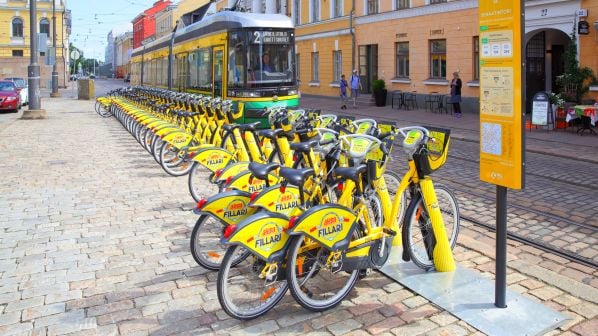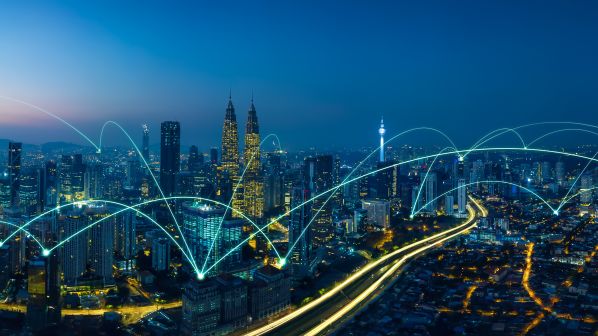TODAY 55% of the global population lives in cities and by 2050 68% of us will be urban dwellers. According to the UN, the world’s urban population grew from 751 million in 1950 to 4.2 billion in 2018 and is set to reach 6.7 billion by the middle of the century. As they grow, cities are coming under increasing pressure to reduce their environmental impact, both for the health of their citizens and the planet.
Alongside rapid population growth, the Fourth Industrial Revolution is set to change the face of cities and how they function. The concept of smart cities is gaining traction as a means of solving economic, social and environmental challenges in urban centres.
Defining what a smart city is depends on who you ask, and the term can have different connotations depending on an individual city’s social and development goals as well as the availability of resources. Digital security firm Gemalto defines the term as, “a framework, predominantly composed of information and communications technologies, to develop, deploy and promote sustainable development practices to address growing urbanisation challenges.”
According to the McKinsey Global Institute’s (MGI) June 2018 report Smart Cities: Digital Solutions for More Liveable Future, smart cities “add digital intelligence to existing urban systems, making it possible to do more with less. With connected applications, users have access to transparent real-time information, enabling them to make better choices.” This makes cities more efficient, more liveable, and more productive places to do business.
According to the Smart Cities Council’s Readiness Guide, the transition to smart cities is being driven by a number of factors. These include: growing urbanisation; increasing stress on urban areas caused by population growth, declining tax bases and reduced budgets; inadequate or life-expired infrastructure; increasing economic competition between cities; growing environmental challenges and the need to significantly reduce CO2 emissions; and rapidly-improving technology.
Research indicates that smart cities technology could have a profound impact on how cities function and indeed could be critical to sustaining the megacities that will be home to much of the global population by the middle of the century. The first benefit is efficiency. With huge pressure on public and household budgets, new approaches to managing urban infrastructure, environments and services could have profound financial impacts. According to a 2017 white paper by ABI Research, smart cities technologies could generate global annual savings of more than $US 5 trillion for governments, companies and citizens by 2022.
Smart city technologies can significantly reduce the environmental impact of urban living. Embedded sensor networks continually monitor pressure, flow and quality in water mains, enabling preventative maintenance before leaks happen. Smart street lighting automatically adjusts lighting levels according to activity in the street, reducing energy consumption at night. Waste bins equipped with sensors enable waste collection services to be optimised. Sensor networks monitor air and water quality, triggering alerts if pollution exceeds safe levels.
In the field of mobility, smart cities provide an opportunity to optimise the capacity and flexibility of infrastructure while aligning services more closely with the needs of individual users. Dynamic pricing can reward passengers for travelling on less-busy routes. Mobility as a Service (MaaS) overcomes the traditional barriers between modes, connecting public transport with on-demand car services, bike hire and walking to provide a seamless alternative to driving from A to B. Intelligent infrastructure enables predictive maintenance, reducing system downtime and enhancing reliability.
With such potentially-transformative benefits, an increasing number of cities are making a business case for significant investments in smart cities. According to BCC Research, investment in smart city technology in North America is set to increase from $US 118.5m in 2016 to $US 244m in 2021.
This revolution begins with the individual. As technology plays an ever-greater role in the daily lives of city dwellers it unlocks new opportunities to interact with the urban environment and on a macro-scale helps to reshape how the city functions. “Smartphones have become the keys to the city, putting instant information about transit, traffic, health services, safety alerts, and community news into millions of hands,” the MGI report states.
“After a decade of trial-and-error, municipal leaders are realising that smart city strategies start with people, not technology. ‘Smartness’ is not just installing digital interfaces in traditional infrastructure or streamlining city operations. It is about using technology and data purposefully to make better decisions and deliver a better quality of life.”
In 2012 urban strategist Mr Boyd Cohen devised the Smart City Wheel, which ranks smart cities according to six criteria:
- Smart economy: a city seeking to position itself as a capital of the new economy and innovation as well as a centre that attracts people
- Smart governance: a city whose public services have entered the digital era with efficient online services, open data, and data-driven services
- Smart environment: a city which reconciles its roles as a living space, for mobility, an economic centre while reducing its footprint on the planet (reduced consumption of energy and natural resources and reduced polluting emissions)
- Smart mobility: the city which organises itself to offer an alternative to car congestion and pollution by promoting the effectiveness of means of collective and sustainable travel
- Smart people: a city which fosters the development of its citizens by levelling out inequalities and encouraging them to acquire skills
- Smart living: a city which considers the culture and wellbeing of its citizens while ensuring high levels of public safety and strong healthcare provision.
Each of the six components of the Smart Cities Wheel are assigned a set of indicators in order to assess a city’s progress in each area. In the case of mobility, indicators include clean-energy transport (cycling infrastructure, bicycles per capita, electric vehicle charging points), public transport (annual number of public transport trips per capita, presence of an integrated fare system), smartcards (percentage of public transport trips using a public transport smartcard), and access to real-time information (including demand-based pricing and multi-modal transit apps).

According to the MGI report, a smart city is constructed on three layers: the technology base, applications and public usage. The technology base includes a critical mass of smartphones, sensor networks and open data portals. The applications layer comprises raw applications translating raw data into alerts and insight. At the top, the public usage level represents the adoption of applications.
The technological foundations for smart cities are rapidly taking shape, and the Internet of Things (IoT) is central to this process. The IT research and advisory firm Gartner forecasts that 14.2 billion connected things will be in use this year, increasing to 25 billion in 2021. Sensor networks will harvest huge volumes of data, generating insights into system status and performance.
Siemens Mobility CEO, Mr Michael Peter, says the automation of rail networks supports many typical goals for smart cities. “There needs to be a three-fold strategy for new railway infrastructure,” he told IRJ last month. “Firstly, you have IoT with everything connected and full availability of all data for predictive maintenance. Secondly, driverless operation gives the ability to be demand responsive. Thirdly, you connect all of these things into one smart system to optimise the operation. If you can achieve a 3-4 second reduction in station dwell time on a metro line you can increase capacity by 10%.”
In Singapore, a world leader in the field of smart cities, sensor network data has been successfully harnessed to optimise transport planning. Under the Smart Nation Singapore initiative, Singapore Land Transport Authority (LTA) used anonymised user data from contactless fare cards and identified commuter hotspots to manage bus fleets with the aim of improving the travel experience for passengers. Arrival times of buses are tracked using sensors installed on more than 5000 vehicles and real-time location data is used to help planners align services more closely with demand.
LTA says the insights it has gained from the data can also help it to anticipate and address the needs of different types of commuters through improved policy planning. The project resulted in a 92% reduction in the number of overcrowded buses, despite a year-on-year increase in average daily ridership, and cut average waiting times on the busiest routes by 3-7 minutes.
“Smart technologies change the nature and economics of infrastructure,” the MGI report states. “They reduce the cost of gathering information on usage patterns - and with an unprecedented volume of data points in hand, city governments, employers, and residents can find new ways to optimise existing systems. Some smart solutions both respond to demand and involve the public in shaping it. They encourage people to use transit during off-hours, to change routes, to use less energy and water and to do so at different times of day, and to reduce strains on the healthcare system through preventive self-care. The result is not only a more liveable city but also a more productive place for businesses to operate.”
MGI forecasts that cities deploying smart mobility applications could reduce journey times by an average of 15-20% by 2025, although the potential of individual applications varies according to the city’s density, public transport infrastructure and travel patterns. In New York, MGI predicts a 15-minute daily reduction in average commuting time, but this figure could be as high as 20-30 minutes for cities with more challenging commutes.
Barriers
Implementing a smart cities strategy is not without challenges and Mr Jesse Berst, chairman of the Smart Cities Council, says there are a number of consistent barriers that have confronted local governments around the globe. Short-term financial constraints mean cities often tackle issues in a piecemeal manner and city functions have long been divided into separate “siloed” departments with little interaction. This is at odds with one of the core requirements of planning a smart city: an integrated, cross-departmental approach to development. According to the Smart Cities Council, failure to reach across those departmental boundaries means projects are often designed to solve a single problem in a single department, creating “islands of automation,” duplicating public expenditure and making it difficult to share systems or data.
To overcome these constraints, the Smart Cities Council Readiness Journey advocates a three-step approach to project development: Envision, Plan and Implement. “Envision is often where cities get it wrong,” Berst says. “Many smart city projects are led by one department working on its own, and the result is a siloed application. So you need to develop a multi-stakeholder consensus, bringing in other departments, perhaps neighbouring jurisdictions, transit operators and so on. Holistic thinking and collaborative working is hard and it takes time up-front, but it saves a lot of time down the line because everyone has agreed what they want and there are fewer objections.”
By adopting a collaborative approach, cities can reuse data and software modules already created by other departments, significantly reducing the development time for a new application.
Customer expectations are another challenge. The explosion in smartphone ownership over the last 10 years has given city dwellers instant personalised access to information and services. Citizens increasingly expect the same level of convenience from municipal services, putting local governments under pressure to step up digitalisation.
Berst says a lack of clarity about what a smart city is and how it benefits the urban population has held back the smart cities movement, with many stakeholders lacking awareness of successful smart city initiatives. Visionary leadership capable of communicating the benefits of smart technologies to a wide audience is therefore essential in securing public backing for smart cities projects.
Many cities are also facing budgetary pressures and a dearth of investment capital. New financing models could help local governments to pursue smart cities initiatives and ensure they remain competitive with their peers. This inevitably leads on to the question of ownership. The MGI report found that the public sector would be the “natural owner” of 70% of the applications examined, but 60% of the initial investment required to implement the overall range of application could come from private sources.
Some public transport authorities are building the capability to develop applications in-house. In 2016, Vienna public transport operator Wiener Linien and its parent company Wiener Stadtwerke established tech startup Upstream Mobility to expand and manage its own digital infrastructure, grow its digital services and strengthen its position as a central integrator for mobility services.
“We’re convinced this new role is better serviced by a public operator embodying public values,” senior strategist, Dr Michael Lichtenegger, said at the LTA-UITP SITCE congress and exhibition in Singapore last July. “Big IT companies will be great suppliers, but public transport should have the knowhow and functions in its own hands, including a central mobility service platform. Digitalised mobility means big data, and the mobility platform is the well for collecting never-ending mobility data. This is a public treasure - why should we give it to Google or Microsoft, then pay to use it with public money?”
Peter argues public transport authorities still have a central role to play in mobility in the smart city. “Transport authorities are going to be more relevant than ever because of the need to think of transport holistically as a system,” he says. “We see road traffic is still increasing in cities despite the arrival of ride sharing services like Uber. In the future the transport authority may need to take control of the overall system and restrict road movements for private vehicles in inner cities. Many cities already understand there’s no way around this.”
Governance
A central principle of integrated mobility is the need for collaboration between modes instead of competition. Technology can only support seamless intermodal journeys if the barriers to integration are removed. Like many aspects of smart cities, this is a matter of public policy and not something that can be left to the market to regulate.
In recent years, Finland has emerged as a country at the cutting edge of smart mobility policy. In January 2018 the Finnish government introduced the Transport Services Act, which requires public transport operators to open up their data and passenger information systems and ensure they are interoperable with those of other operators. Following the introduction of the new law, Uber returned to Helsinki but in common with all other public transport providers, the ride-hailing firm is legally obliged to open its Application Programming Interface (API) and allow third party providers to buy and resell Uber rides through their own applications.
“The Transport Services Act is, to a very large extent, about preparing for the future,” Mrs Anne Berner, Finland’s transport and communications minister, said in May 2017. “Our legislation has to be flexible so that all parts of the transport system will work together. This act will give us a genuine opportunity to make mobility a comprehensive service for customers. Finland is a pioneer in this work, which gives us a competitive edge.”
This regulatory intervention supports the development of MaaS, integrating end-to-end trip planning, booking, ticketing and payment across all public and private transport services via a smartphone app. Helsinki was the first city to provide a full-scale MaaS offering and today there are more than 45,000 users of the city’s Whim app, 5100 of whom pay a monthly fee for the service.

Helsinki is an example of governance and technology working in unison in public transport, and Berst says it will be crucial for cities to carefully maintain this careful balance in the digital age. “Governance is every bit as essential and empowering as the technological assets but you have to have the technology to stay relevant. It’s clear that we are going to see a complete transformation in the transport sector, probably within the next 10 years and definitely within the next 20 years.”
While the term smart cities might infer notions of hidden forces controlling even the minutest aspects of our daily lives, the concept is less like a science fiction movie and more about finding a balance between technology, governance and the needs of people and businesses. The ability of local governments and other stakeholders to develop robust smart cities strategies will be crucial in addressing the future challenges facing the world’s urban population.

